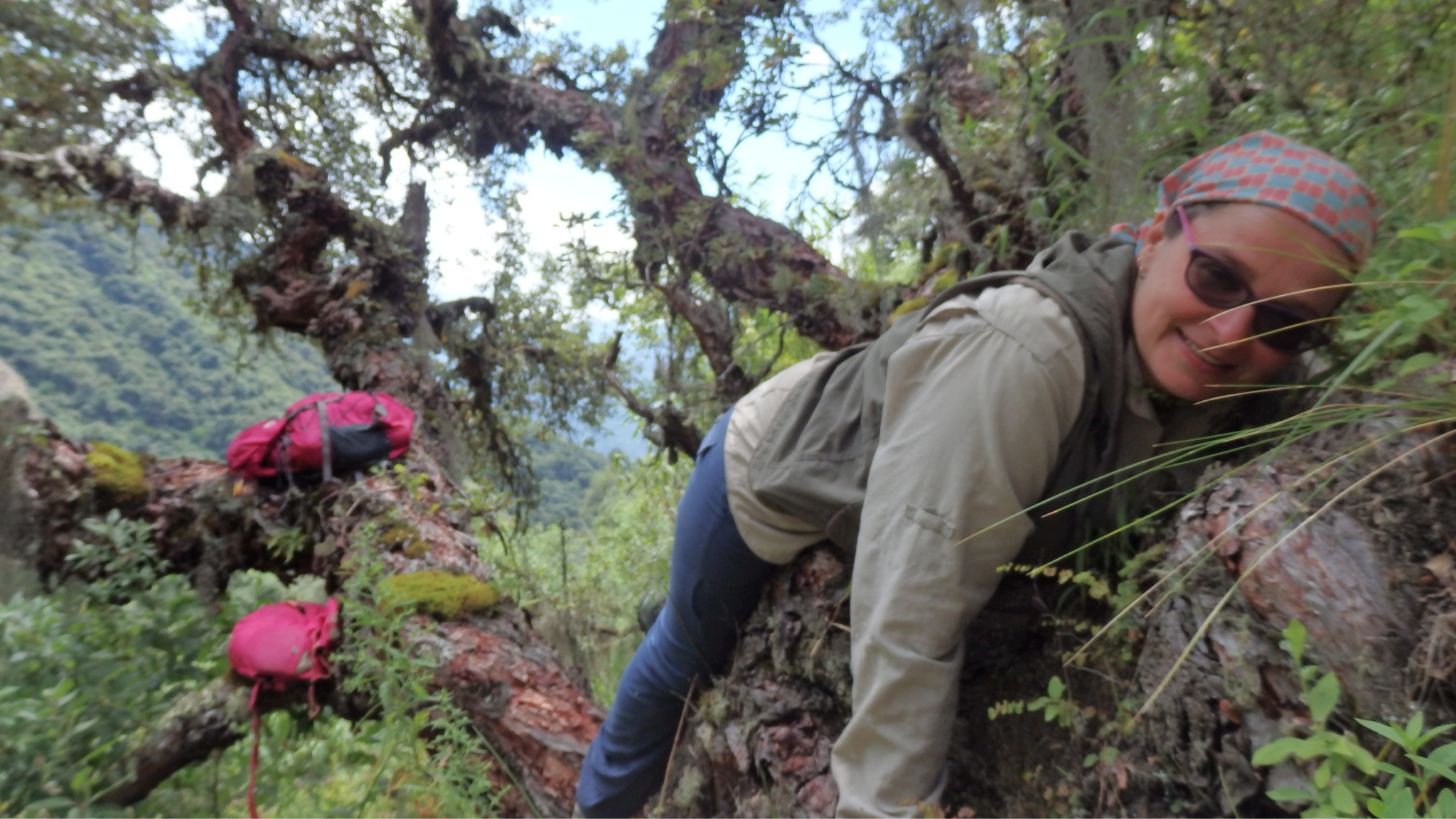
From conserving wild cats to queñoa trees—a career switch, with “no regrets”
After over a decade leading efforts to protect Argentina’s wild cats, Dr Erica Cuyckens, Assistant Researcher at the National Scientific and Technical Research Council (CONICET) in Argentina, describes her recent career change to focus on the conservation of queñoa trees – and why she has no regrets.
Migrating from Belgium to Argentina as an exchange student at the age of 18, it wasn’t long before Erica Cuyckens fell in love with the country’s impressive natural heritage. She eventually went on to pursue a PhD on the distribution of threatened Argentine wild cats and decided to make the country her permanent home.
In 2010, Erica received a grant and training from the Conservation Leadership Programme (CLP) to support her research and community outreach work in Yungas, northwest Argentina, focused on conserving the rare and understudied little spotted cat (also known as the northern tiger cat – Leopardus tigrinus). After this project uncovered key evidence showing just how rare these cats were in the region, and the threats they face, Erica went on to work for another decade revealing more vital information and raising awareness about these perilously threatened felines.
So why, after dedicating her career to wild cats for so long, has Erica decided to switch her focus to protecting queñoa trees?

A queñoa tree.
Queñoa trees: icons of the Andes
A group of trees endemic to the Andes from Venezuela to northern Chile and the centre of Argentina, queñoa trees (species of the Polylepis genus) are found at the highest altitudes on Earth. “These trees are very beautiful and represent great strength by growing in dry harsh environments, resisting wind, cold, and intense sun rays,” says Erica.
For Erica and other plant conservationists, one of the major reasons to protect these trees is their importance in regulating water cycles and avoiding erosion in areas where erosion can completely eliminate the fertile soil.
Northwest Argentina is considered a hotspot for queñoa trees, with the region harbouring five species—two of which are listed as Vulnerable on the IUCN Red List. “In the high-Andes and Puna, it is the only type of tree present and therefore holds a lot of cultural importance for local communities and their identities,” says Erica.
Yet, despite their cultural and scientific importance, information about queñoa trees in the region is extremely scarce. We know this thanks to an intensive literature review performed by Erica and her colleagues, which she recently presented at the International Congress for Conservation Biology in December 2021.
Sowing a seed of hope
Erica also describes her motivation to switch to queñoa trees as a political moment, when Argentina’s political panorama needed scientific input on forest ecology: “The authorities were voting to ensure that the National Forest Law established forest conservation management opportunities, so scientific information had to be generated and made available for decision-makers.”
After having previously undertaken an internship working on queñoa trees in the Laboratory of Ecological Investigation in Yungas (LIEY Tucuman, Argentina), Erica already knew there was very little information available and a lack of knowledge on the genus, especially in northwest Argentina. She realised that information on their conservation status had to be urgently updated to ensure these species were included in the National Forest Law.
But it wasn’t just a political moment; she was coming back to an old love. Her internship at LIEY Tucuman had sown a seed, which had germinated belatedly (as, Erica says, a queñoa seed would!)
She also felt some relief at finally being able to see her study object: “Felines are so rare that fieldwork and data collection could sometimes be frustrating. Instead, trees you can see, touch, embrace and measure!”

A Polylepis australis seedling.
A career switch with “no regrets”
The career switch wasn’t all smooth sailing, however. She had to convince her employer to allow her to make the change and almost went back to wild cats, before realising she needed to work with new people and change her working environment.
Another big challenge for Erica, which many conservationists are all too familiar with, is the difficulty getting funded: “As wild cats are very charismatic and beautiful animals, I never had problems getting grants so I was surprised when this did not happen for queñoa trees!”

A jaguar skin near Alisar, Argentina. Credit: Fernando Falke.
Reflecting on the challenges she’s encountered over her entire career journey, Erica describes the difficult preconceptions she faced studying and working as a woman and a migrant in Argentina: “There were times when I faced prejudice like, “you will never get up that hill, less even because you’re a little girl”. Or “what would she know, she wasn’t born here” – but I now know that I visited more places than some locals of the big cities!”
Despite the challenges, Erica has no regrets about her career choice and decision to change her conservation focus, describing her biggest rewards as teaching young children about conservation and convincing local people to conserve species, whether it’s cats or queñoa trees.

Explaining camera trapping to school children. Credit: Ariel Cazon.
“A tree with a view”
Erica explains that, with her beloved queñoa trees growing high in the highest mountain areas, surveying them always involves a climb, with a beautiful view as a reward – or as she calls it: “a Tree with a View”.
“Visiting the places where the tree grows always allows me to meet new local communities with whom I make profound friendships, which make me want to go back to the field whenever I can,” says Erica.
And it seems that Erica has made a wise career change, because the area of queñoa conservation is suddenly booming. For the first time, a group of young students is starting their own independent project on the ecology of these trees. Erica has also recently been invited by a local community of the Puna of Jujuy to set up a reforestation project, and together with the community, is now gathering and sowing the first Polylepis tomentella seeds.
“Working with local communities is very beautiful and it fills my heart with pride that they trust me and have invited me to work with them, and that they are worried about conservation and reforestation,” says Erica.
To those conservationists just starting out in their career, or considering a switch in conservation focus, Erica says that passion is vital, to never give up, and do exactly what you want, even if it might be more difficult or take longer. She advises taking time to get to know your study object, the places you will work, and most of all: the people who live there and who should take over from you to continue your work.
Author Profile | Kate Tointon

This interview is based on an article originally published on the CLP website.
Main image: Embracing a queñoa tree. Credit: Sebastián Marquez.
Careers Advice, Interviews, Educator, Scientist, Community Conservation






